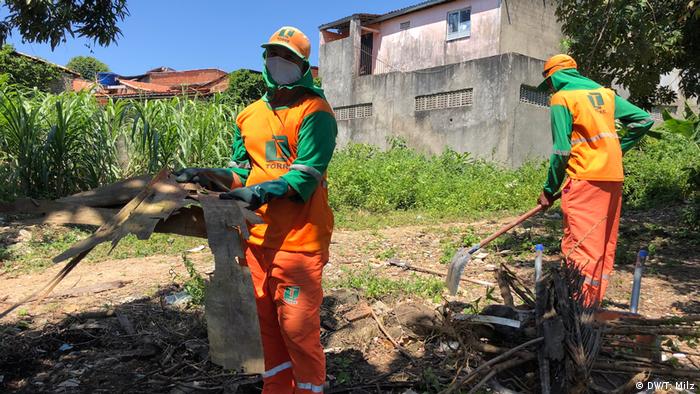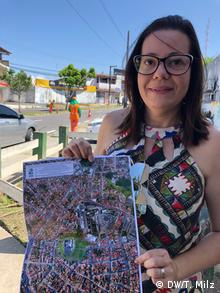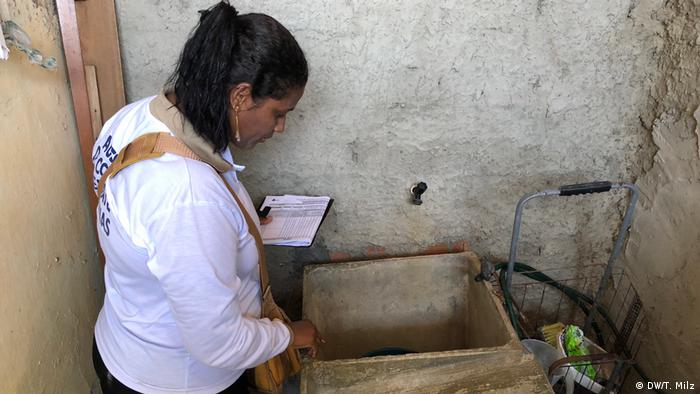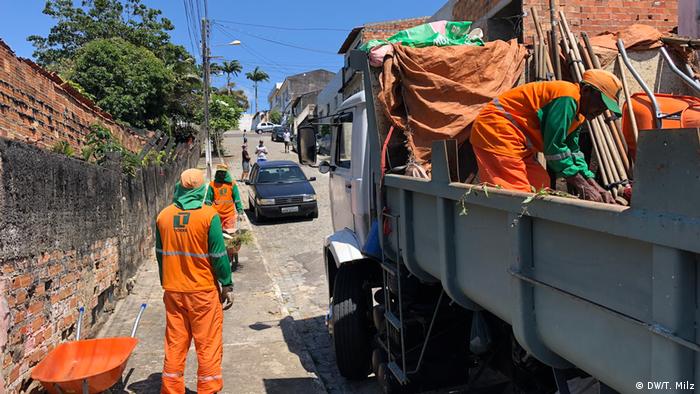The number of Dengue disease in the country has increased in 2019 to 600 percent. Our report from the state of Sergipe shows why the fight against the disease and its Vector, the tiger mosquito, is so difficult.

Vanesca Barbosa holds a map of the district of Palestine in the hands. Everywhere, to see where red dots are going to look at today, says the health Secretary of Aracajú, the capital of the Federal state of Sergipe in the North-East of Brazil. Because the red dots are sites of potential nesting grounds for the Egyptian tiger mosquito: “bowls, buckets, sinks, water tanks, everything collects where the water. Eighty percent of all problems are concentrated in the homes of the people,” says Barbosa.
The tiger mosquito, known in Germany as the yellow fever mosquito, transmits the disease to all sorts of virus: including Chikungunya, Zika and Dengue. All three Virus diseases in Brazil. But especially Dengue: 1.4 million cases were registered since the beginning of the year, six times as many as in the prior-year period.
Days earlier, a Team of the municipal environmental office drone had photographed the neighborhood in the poor periphery of the city, and then 989 single shots, the card set together. Now it is indented, with 120 men, and fifty of the employees of the health Department who go house to house, to check one after the other, and seventy employees of the city cleaning.

On the basis of the drone images, the health created office of Aracajú a map of potential breeding sites
From the garden of Elaine Lorenço drag old Sofas, car tires and plastic waste. The neighbors, says the 32-Year-old, would have kicked over your fence. “We ask you to throw any garbage over, but you do it anyway, in the middle of the night or early in the morning.” Collects in the waste water, it is the perfect breeding ground for the Dengue mosquitoes.
“You don’t often believe that there is Dengue really”
Elaine is afraid for her family. Her nephew had recently spent 15 days in the hospital with Dengue, your mother also. She has a nine-month-old Baby and a six-year-old daughter, who could be sick. Just like the four-year-old Antony that helps diligent with the clean-up.
Two streets further Ronisy Santos to look at from the health Department in a backyard. The dogs of the old lady who lives here, didn’t you want to allow in the first place to the sink. What are you looking at first? “After the water reservoir, in order to see whether there are larvae.” Also in the big blue water tanks on the roofs of most houses, nesting the mosquitoes: “The are very often left open, and then the larvae since hatching,” says Santos. “We are always with the people, explain it to you, but you don’t get it often, unfortunately.”
The men and women of the Department of health, know already where the greatest difficulties lie: “It is often the old people who do not believe that there is Dengue really. No matter how often we explain it, you don’t just accept that,” says Edina Andrade Pereira from the health Department. “This is exactly as in the case of vaccinations, you don’t want to, because they believe that they are harmful,” adds her colleague Vanesca Barbosa.

Each container under the open sky can embellish the tiger as a hotbed serve as soon as water accumulates therein,
The backwardness and the lack of Knowledge the people are so fatal. “That’s a cultural issue,” says health Secretary Vanesca Barbosa. You’ll meet mountains in some of the houses on all the garbage. “And people think it’s normal. It is a risk for the whole neighborhood.” The worst of the “garbage collector” is to be psychologically cared for, to change your behavior, so Barbosa.
The fever is coming to town
In Sergipe Dengue width in this year, increasingly also in the rainy coast range, reported Sidney Sá, which is in the state government for the control of epidemics is responsible. Previously, the fever had occurred, especially in the dry Hinterland: “The lack of water that affects many communities, forcing people to hoard water, and they do it on the wrong way.” All too often, the employees of the Sás Team, insecticides need to scatter into the open water tanks.

Together with the city of cleaning the health Department is trying to reduce the spread of the tiger mosquito
For years, Sás draws squad by Sergipe, and on clarifying the population. However, the Dengue-believe fever, she says, stubbornly. And some of the residents, reported Sá, filter the water or boil it before you drink it to kill the mosquito larvae. You don’t understand that Dengue is transmitted by the bite of mosquito, not by Drinking the contaminated water, says Sá: “We need to ensure that the population understands the Problem, and we will ask you for your help.” But often pointless.
Added to this is the haphazard Sprawl of cities, the destruction of nature, as well as the lost climate, with unusual periods of rain – all of which were factors, of which the mosquitoes benefit. In addition, Sá missing from time to time appropriate personnel, as well as simply find the money for their actions. And from time to time, even the insecticides for Mosquito control.
Currently, the authorities of Sergipe count around 4000 Dengue cases, with 2.3 million inhabitants in the Federal state. The are much more than in the previous year, but in other regions the Figures are even higher. And also in Sergipe there were once a lot more cases: “In the last great epidemic, in the year 2008, we had 70.000 cases with 56 deaths,” says Sá. Nevertheless, it considers the risk this Time, too, for, he says, “This epidemic is different: We have a lot less cases, but still been twelve deaths confirmed.”
In most cases, it was the Dengue type 2. “This Form is much more aggressive, with short periods of time between the first symptoms and the onset of death.” For the squads in the cities and in the country, Mosquito control becomes a race against time.